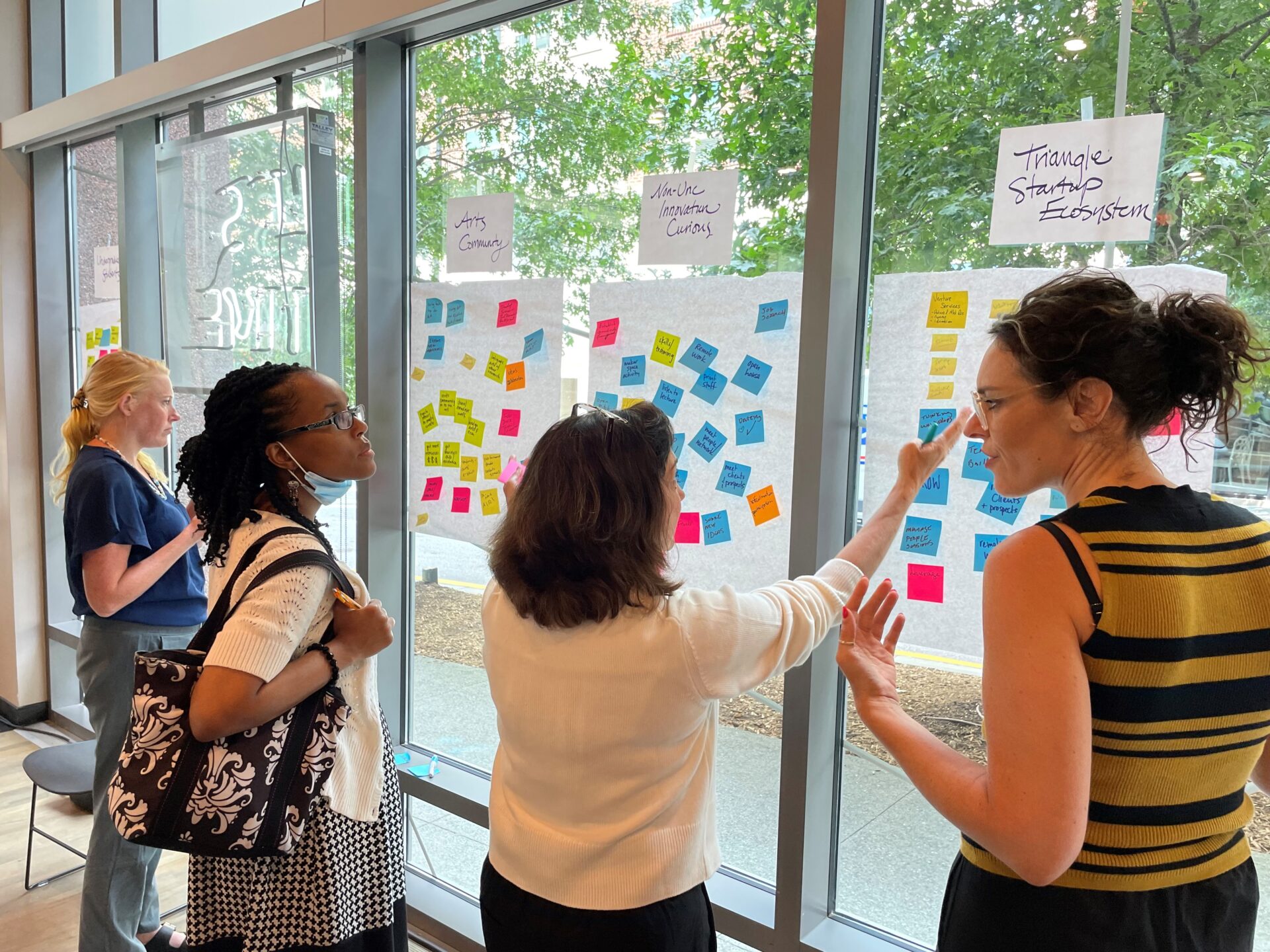Innovate Carolina talked with two of UNC’s design thinking experts to explore the phases of this problem-solving method: Liz Chen, assistant professor at the Gillings School of Global Public Health and Innovate Carolina’s design thinking lead; and Cristina Leos, adjunct professor at the Gillings School of Global public Health and senior innovation strategist, City of Raleigh Municipal Government. Liz and Cristina will be co-teaching the required course for the graduate Certificate in Innovation for the Public Good in the Fall 2022 semester.
In a three-part series, we explore key phases of design thinking: inspiration, ideation and implementation. This week, we look at implementation.
1. What is the implementation phase?
Liz: The implementation phase is the third of three phases: inspiration and ideation being the first two. In the first two, you’ve made sure that the problem you’re looking to address is truly the problem and gain greater context and inspiration. Then, in ideation, you’ve gone through a series of activities to create choices, make choices and begin to test those ideas in the real world. The third phase, implementation, is where you’re really trying the ideas in a bigger way and with more real-world context, while also thinking more about the viability of a solution.
So up front, you’re really thinking more about desirability first, then feasibility. Implementation has a heavy focus and emphasis on viability. As you’ve dreamed up the concepts and tried them and you understand what makes a solution work, how do you get those solutions to be successful long-term? In a business sense, once the initial funding goes away, how it can sustain?
2. What are key steps in this stage?
Liz: Ideally, you won’t start evaluation and measurement in the implementation phase, but it is important to stand up ways to continue to measure even after you’ve launched your product or service. Some of our students, faculty and clients do a lot of data collection up until launch and find success in that, but they forget there should be continuous improvement and data collection. You want to make sure that once things are implemented in the real world, they will go as smoothly as you envisioned.
An important step is making sure that you have a measurement and evaluation plan that continues over time. In addition, there needs to be continuous feedback loops with real people as you continue to grow whatever product or service you’ve launched. We can’t assume that we’ve arrived and that whatever we put out the first time is perfect and needs no improvement. And so to do that, what are the resources needed? People, money and others to ensure that we are still continuously learning.
Cristina: One high level way to think about the implementation stage is that this is where you start to think of a longer-term roadmap. You can start to build more complexity into your plan as you think about growth – who does it serve, how does it work, how many people does it reach?

“The implementation phase is where you can think about a longer-term roadmap for your solution. Now that we know a little bit more about what the solution does, who it serves, how it works and how it will be implemented, you can think about more complex questions such as what does growth mean?”
Liz Chen, assistant professor, Gillings School of Global Public Health; design thinking lead, Innovate Carolina
Liz: Yes, I agree. The implementation phase is where you can think about a longer-term roadmap for your solution. Now that we know a little bit more about what the solution does, who it serves, how it works and how it will be implemented, you can think about more complex questions such as what does growth mean? Does it mean we are reaching more people? Are we providing more services? Are we going deeper into an area? Those questions around “what does it mean to grow and scale the solution?” are new and interesting concepts that you can explore in the implementation phase.
3. What methods are used in this phase?
Liz: I think two methods that are really helpful and popular include live prototyping and creating a pitch. At the end of your ideation phase, you should have a portfolio of ideas that you start to test in small bits and pieces with real people. As those ideas and concepts get fleshed out, it’s important to make them real enough that you can put them in front of customers, audience members and essentially have your research team or design team observe these products and services being used live to collect that data either by watching them or collecting back-end data. Prototyping really is a useful tool as it creates versions that are real enough that people can use. Not only can you ask them about your products, but you can also start to create more meaningful behavioral data.
The other key method is creating a pitch. It seems so obvious, but up until this point in the design thinking process, we have spent a lot of time focusing on the end user, customer or audience member. We’ve wanted to understand their specific wants and needs and the value proposition that your solution brings. But sometimes, those people aren’t the people paying for the product or service. For example, if you are creating an app for kids to use in schools – even though you may have conducted a lot of inspirational activities and ideation with kids K-12 – it ultimately might be the school district or parents who will pay for the product. So the creative pitch should tailor your value proposition statement to those key stakeholders, especially those who have the power to make decisions about financing. You also need to figure out the content and delivery method that works best for all those people. So it might be a conversation with no visual materials. It might be only visual materials or a pitch video. Or it might be something more formal like a pitch deck in front of a board of investors. The time and care that goes into creating a very intentional pitch needs to be invested at this stage.
Cristina: A couple other methods I would mention for the implementation phase are creating a theory of change and a logic model. At this stage, those are both really important for understanding, from beginning to end, what do we think is happening with our solution? How does implementation work? What impact goals are we pursuing? It will change and need to be updated, of course. We are not done, and we are still iterating. But those are two tools that you can use at this stage to make sure that you’re making progress on the impact goals set up in the first place.

“Having a tool out in the real world, that’s what the implementation phase is all about. It is also important to map out a series of questions you need to answer in order for long-term sustainability to occur. Using those questions as a framework to guide you… what happens next?”
Cristina Leos, adjunct professor at the Gillings School of Global public Health and senior innovation strategist, City of Raleigh Municipal Government
4. What is the end goal of the implementation phase?
Liz: You have your solution, and it lives in the world. You also have the infrastructure set up for continuous improvement and evaluation, and you are confident that it is sustainable with regard to resources, including people and money.
Cristina: Having a tool out in the real world, that’s what the implementation phase is all about. There is something that people can interact with and use in some capacity. At this stage, it is also important to map out a series of questions you need to answer in order for long-term sustainability to occur. Using those questions as a framework to guide you… what happens next? What is the next improvement that needs to happen? What data do we need to collect in order to know that, yes, this is sustainable and feasible? There are many questions that we can ask in terms of the long-term sustainability of this product.
5. For those looking to try out design thinking, do you have any guidance or words of advice?
Liz: Sometimes we get a deer-in-headlights reaction from participants after a workshop. Their concern is that we are asking folks to forget everything they already know as experts in their own fields and to learn design thinking in its entirety before they begin implementing these concepts and methods in their own work. Neither of these things is true. We really do see the design thinking toolkit and its mindsets as complementary to everything folks already bring to the table, and we don’t expect everyone to understand design thinking in its entirety before trying it. The beauty of design thinking is that you can combine it with other frameworks and methods. And you can start using and applying design thinking even if it is as small as one discrete method or activity. Hopefully, that will lower the activation energy needed to get folks to start doing it. We hope that as they start to learn more and embed these methods into their work, they’ll start to see the benefits and then be intrigued to come back and learn more.
Cristina: I would add that sometimes people hear the word “innovation” and think that we are going to completely turn an institution upside down or replace everything with an app and do all this crazy stuff. But that isn’t necessarily true. The point of using these methods is to find a new perspective on the issues you are tackling. And it doesn’t have to be a brand-new concept that hasn’t been tried before. It is sufficient for it to be new to your problem and to provide an improvement, a better service or a better product. Innovation is not a scary process.
6. How can Innovate Carolina help with resources for each phase of design thinking?
Liz: For anyone interested in learning how we can begin to integrate design thinking into your own research and practice, Innovate Carolina offers a free consultation.
Another way to dip your feet into this content and explore whether this is a good fit for your future strategy work is to consider partnering with our HBEH 748 Design Thinking for the Public Good course. We look for community partners for our fall and spring courses. Student teams work with community partners and apply design thinking to their specific challenges. For more information about the free consultation through Innovate Carolina, the design thinking course or to join its waiting list, you can call or email me at 781-888-0093 or liz.chen@unc.edu.
Ready to incorporate design thinking into your work or research? For additional questions on how to get started with design thinking, explore Innovate Carolina’s design thinking services or contact Liz Chen at Liz.Chen@unc.edu.

 | UNC-CH
| UNC-CH




